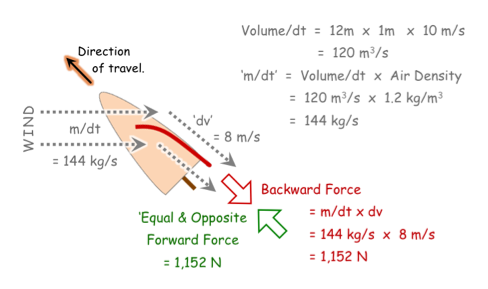This is a follow up question to the question I asked yesterday: Problem understanding basic sail mechanics
I am focusing purely on the Newtonian aspect of motion and I am computing this as follows:
First I compute the relative wind ($v_r$) velocity by subtracting the ships velocity ($v_s$)from the true wind velocity ($v_t$)
$v_r = v_t - v_s$
Next I take the normal of the sail (in to the wind), $n_s$, and "bounce" the wind off it, computing the out velocity of the wind, $v_{out}$
$v_{out} = v_r - (2 * v_r \cdot n_s) * n_s $
Next I compute the change in wind velocity, $\Delta v$
$\Delta v = v_{out} - v_r $
This is linearly proportional to the force the sail exerts on the air, hence $-\Delta v$ is linearly proportional to the force exerted on the boat.
Next, I compute the keel force that offsets the horizontal part of the sail force, allowing the boat to move against the wind.
I take $n_k$ to be the normal of the keel going in the opposite direction to the sail force and perpendicular to the boat heading. I then compute the keel force, $F_k$ to be
$F_k = n_k * |-\Delta v|$
i.e. the magnitude of the sail force in the direction of the keel (perp to direction of boat facing).
To compute the resultant force, I of course sum these two forces.
Firstly, is all that correct. Clearly it is missing resistance from the water, but aside from that, do the calculations correctly reflect the answer given in my previous question.
Secondly, what parametrises these forces and how. What I am seeing at the moment is, when sailing with the wind, the boat accelerates very quickly (up the the speed of the wind). However, when I try to sail near to the wind (is that the correct phrase? for when my boats forward and the direction of the wind are near and opposite) although I can see the apparent wind speed increasing, the force applied is still very small. Is this was you would expect to see?

